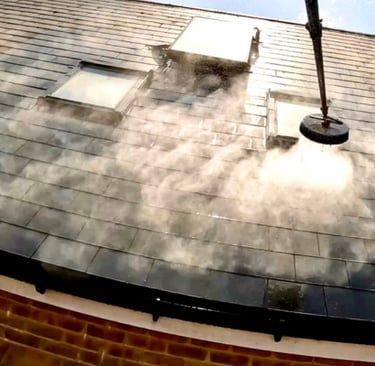Roof Cleaning FAQs
How we do it?
7/20/20251 min read


The frequency of roof cleaning depends on several factors:
Roof type: Asphalt shingles, metal, tile, and slate have different cleaning requirements.
Climate: Areas with heavy rainfall or snowfall may require more frequent cleaning.
Surrounding environment: Trees, pollution, and proximity to water bodies can affect roof cleanliness.
Generally, it's recommended to clean your roof every 5-7 years. However, if you notice significant moss, algae, or debris buildup, you may need to clean it more often.
A clean roof is essential for maintaining the overall health and longevity of your home.
Prevent Water Damage: Moss, algae, and debris can accumulate on your roof, trapping moisture and creating conditions for leaks. Regular cleaning removes these elements, reducing the risk of water damage to your roof and interior.
Protect Roof Structure: Organic growth like moss can penetrate shingles, causing them to deteriorate prematurely. Cleaning removes these organisms and helps preserve the roof's structural integrity.
Improve Curb Appeal: A clean roof significantly enhances your home's appearance and can increase its value.
Why Cleaning Your Roof?
How Often Should You Clean Your Roof?
The appropriate cleaning method depends on your roof type and the severity of the dirt or grime.
Soft Washing: This low-pressure method uses a detergent solution to remove dirt, algae, and moss without damaging the roof. It's suitable for most roof types.
Pressure Washing: This method uses high-pressure water to clean the roof. While effective for removing stubborn dirt, it can damage shingles, so use caution and consider alternative methods.
(This service is preferred by REDY window cleaning. Also we recommend this service as the best roof cleaning service in Kidbrooke, Blackheath, Greenwich and all South East London areas because this method removes moss, algae, and debris caused by the large amount of trees growth in the area in a safe way.)
Manual Cleaning: For stubborn moss or algae, you can manually scrape it off with a soft brush, but be careful not to damage the roof. Moss removal from roofs can be time-consuming if it is not done properly or without the right tools.
What are the best Cleaning Methods?
Bexley
Blackheath
Croydon
New Eltham
Areas we cover:
Bexleyheath
Bromley
Greenwich
Orpington
© 2023 REDY window cleaning
Beckenham
Chislehurst
Eltham
Sidcup
